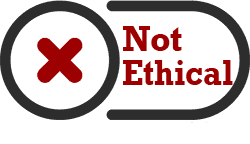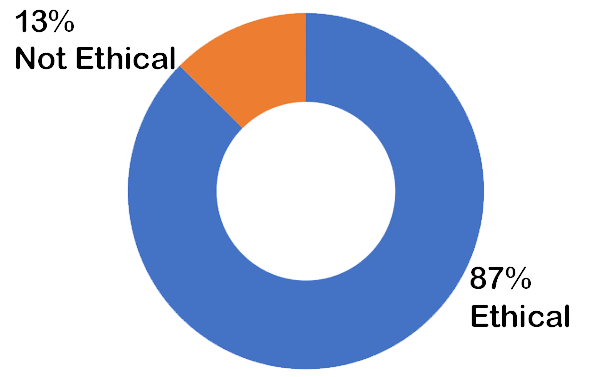This is the April 2021 edition of our monthly series of Ethics case studies titled What Do You Think? This series is comprised of case studies from NSPE archives, involving both real and hypothetical matters submitted by engineers, public officials and members of the public.
Your peers and the NSPE Board of Ethical Review have reviewed the facts of the case as shown below. And, here are the results.
Your opinion has been registered for the April 2021 edition of our monthly series of Ethics case studies titled What Do You Think?
Your vote is recorded as:

Want to know how your peers voted? We’ll send you an email with the poll results on April 27.
Your opinion has been registered for the April 2021 edition of our monthly series of Ethics case studies titled What Do You Think?
Your vote is recorded as:

Want to know how your peers voted? We’ll send you an email with the poll results on April 27.
A Review of the Facts
Engineer Bruce serves as a peer reviewer in an organized peer review program developed to assist engineers in improving their professional practice. When originally selected as a peer reviewer, Bruce is asked to sign a “confidentiality agreement,” whereby Bruce agrees not to disclose confidential information involving peer-reviewed firms.
As part of a peer review visit, Bruce visits Engineer Rick’s firm. Following a review of the technical documentation in connection with a series of recent design projects involving Rick’s firm, Bruce discovers that Rick’s work may be in violation of state and local safety code requirements and could endanger public health, safety, and welfare. Bruce immediately discusses these issues with Rick in an effort to seek clarification and early resolution. Bruce and Rick are unable to resolve the issue, and Bruce subsequently informs the appropriate authorities about Rick’s potential violation of the safety code.
Was it ethical for Bruce to inform the authorities about Rick’s potential violation of the safety code?
Here is the result of our survey of your peers:

Applicable NSPE Code References:
Code II.1.f: Engineers having knowledge of any alleged violation of this Code shall report thereon to appropriate professional bodies and, when relevant, also to public authorities, and cooperate with the proper authorities in furnishing such information or assistance as may be required.
Code III.4: Engineers shall not disclose, without consent, confidential information concerning the business affairs or technical processes of any present or former client or employer, or public body on which they serve.
Discussion
Through the years, various professions, including groups within the engineering profession, have successfully developed peer review programs. These voluntary programs have been immensely successful in creating a mechanism whereby professionals in a collegial atmosphere can work with one another in an effort to understand and improve professional practice. This can be accomplished by analyzing and evaluating the actions, decisions, and techniques of the professional and offering constructive and, at times, critical feedback. Peer review enhances professional practice.
One of the hallmarks of engineering peer review programs has been the fact that such programs are built on a foundation of confidentiality, whereby an individual agreeing to serve as a peer reviewer must sign a “confidentiality agreement” in which the peer reviewer agrees not to disclose information that is revealed to the peer reviewer about the firm being reviewed during the course of the peer-review process.
There are sound reasons for such an approach. Firms being peer-reviewed should be encouraged to provide as much pertinent detailed information to the peer reviewer to allow the peer reviewer the opportunity to perform a thorough evaluation of the firm, and confidentiality helps to assure that the maximum amount of disclosure will occur. In addition, confidentiality helps build trust between the parties involved in the peer-review process and promotes an atmosphere that will improve the likelihood that the peer review process will be mutually productive and ultimately successful.
While the merits of confidentiality are clear, the Board of Ethical Review is faced with a situation in the present case where Bruce, the engineer performing the peer review, discovers that the work of the engineer being peer-reviewed, Rick, may be in violation of state and local safety code requirements and could endanger public health and welfare. This ethical dilemma appears to involve two separate provisions of the NSPE Code of Ethics – Code III.4 and Code II.1.e.
The BER has considered at least one case involving an engineer gaining knowledge of information damaging to a client’s interest, which involved the public health and safety (see BER Case 76-4). On the one hand, the engineer has an obligation not to disclose confidential information concerning the business affairs or technical processes of any present or former client without their consent. On the other hand, Bruce, having knowledge of any alleged violation of the Code of Ethics, has an obligation to cooperate with the proper authorities in furnishing such information or assistance as may be required.
Weighing the competing considerations in this case, the Board of Ethical Review is of the opinion that Bruce will have to exercise appropriate judgment and discretion concerning this matter depending upon all of the facts and circumstances. If Bruce determines that there is an imminent risk of harm to the public health and safety such as loss of life, serious risk of injury to persons or property, Bruce must immediately take appropriate steps by notifying Rick. In the event that Rick fails to take appropriate corrective actions, Bruce may cooperate with proper authorities in furnishing such information or assistance as may be required. While confidentiality is an important ethical value, as a licensed professional engineer, Bruce’s paramount responsibility is to protect the public health and safety.
Assuming from the facts that Bruce determines that Rick’s work may be in violation of state and local safety code requirements and could endanger public health and welfare, a more appropriate action would be for Bruce to expeditiously discuss these issues with Rick in an effort to seek clarification and early resolution of this issue. If Bruce and Rick are unable to resolve the issue, Bruce must inform Rick that as a professional engineer, his only alternative is to cooperate with the proper authorities as indicated above.
The Ethical Review Board’s Conclusion

It was ethical for Bruce to inform the authorities about Rick’s potential violation of the safety code.
BOARD OF ETHICAL REVIEW
James G. Fuller, P.E., William W. Middleton, P.E., Robert L. Nichols, P.E., William E. Norris, P.E., Paul E. Pritzker, P.E., Jimmy H. Smith, P.E., C. Allen Wortley, P.E. (Observer), Donald L. Hiatte, P.E., Chairman
Note – In regard to the question of application of the Code to corporations vis-a-vis real persons, business form or type should not negate nor influence conformance of individuals to the Code. The Code deals with professional services, which services must be performed by real persons. Real persons in turn establish and implement policies within business structures. The Code is clearly written to apply to the Engineer and it is incumbent on a member of NSPE to endeavor to live up to its provisions. This applies to all pertinent sections of the Code. This opinion is based on data submitted to the Board of Ethical Review and does not necessarily represent all of the pertinent facts when applied to a specific case. This opinion is for educational purposes only and should not be construed as expressing any opinion on the ethics of specific individuals. This opinion may be reprinted without further permission, provided that this statement is included before or after the text of the case.









If memory serves me correctly, in the book of Ezekiel, the paradigm of the watchtower is used. If the watch blows the trumpet and no one listens, the blood is on their heads. If the watchman sees the danger and does not blow the trumpet; the blood is on his hands.
He should have gotten another opinion from a peer reviewer first. If both agree than inform the authorities
The problem statement says that Bruce sees a potential health and safety issue. I believe that the proper way to deal with this issue would be to determine if there really was an issue. Also, if Bruce felt that he must take this to another level he should encourage the owner of the engineering firm to go with him. The desire is to resolve the problem. Bruce will be unwelcome at other firms if he does not attempt to resolve the issues and help the firm that he was auditing. I know that the problem indicated that Bruce tried to negotiate with Rick but there is no detail. I would think that Rick would not want Bruce going to the authorities without being able to present his side of the case explaining why this was not a safety issue.
Bruce signed a “confidentiality agreement”. Bruce needs first to send a formal letter to Rick with the shortcomings of his design and give him a time limit for Rick to revise and correct the design before contacting the authorities. This way he is absolved of his confidentiality agreement.
In the example above, it states that “Ricks work MAY be in violation of state and local safety code requirements and COULD endanger public health…” Based on the example given it sounds like a difference of opinion or interpretation of the code. The only time I would break a confidentiality agreement is if it was a situation of IMMINENT risk of harm. In the example given the words like COULD and MAY do not rise to imminent risk. Before reporting situations to authorities, one had better be sure that there IS a code violation and that there IS IMMINENT risk. A better solution would have been for Bruce and Rick to agree to get a third opinion.
He should have asked Rick to report the violations.
This is one of the ethical case studies that either assumes the engineers involved are sole proprietors (not stated in case study) or does not recognize that there is a chain-of-command that can be followed within either engineer’s respective company that offers a path to resolution prior to contacting regulatory authorities. I agree that this ethical concern should be further pursued since the two engineers were unable to resolve on their own.
Key phrase is, “may be in violation” which to me indicates it “may be a difference of opinion”. If it is clear and unambiguous that violations are taking place, I believe Bruce’s actions are necessary and appropriate, but if is isn’t clear cut, I think the NDA should be respected.
This was a difficult decision; I agreed with the ruling to an extent.
I am thinking in practice that Bruce should have presented the issue to his client, the peer review firm he is employed by and the peer review firm should have made the decision to report. If his client (not his clients’, client) refused to report the issue then it would be Bruce’s professional engineering obligation to report the matter to the authority having jurisdiction.
Peer review will sputter and go away without confidentiality. There must be another way to deal with this?
I agree – discuss first with Rick and give him a chance to correct the errors with the client in a reasonable time but failing correction by Rick Bruce must report the shortfall or himself be negligent
The purpose of the confidentiality agreement in this context is to protect the various companies’ business interests, not to provide an impenetrable shield contrary to legitimate public interests regarding health and safety. It is likely that Bruce can furnish information to the appropriate authorities without disclosing proprietary information or trade secrets. If the bridge is going to fall down or the building may collapse, the calculations or materials of construction are not going to be priviledged information.
I think the details needed to be a little less vague on how Bruce and Rick left this issue. Simply stating they were unable to resolve the issue could mean it was complex and couldn’t be immediately solved that day, or that Rick was stubborn, uncooperative, and not willing to address the issue. If the first case, the story sounds like Bruce is quick to run off and say “look what I found Rick doing wrong” while Rick might actually be trying to continue resolving the issue. In the second case, I agree Bruce needs to put public safety before client confidentiality.
You know, these cases ae getting tiresome. An ethical dilemma is presented that has no good options and we’re supposed to decide. A plethora of Hobson’s choices.
Let’s see… A trolley is hurtling uncontrolled down the tracks. You are standing by a switch on the tracks. If you do nothing, the trolley will continue down the track and run over a squad of blind cub scouts in wheelchairs. On the other hand, if you switch the trolley to the other track, the trolley will run into a truck filled with dynamite stuck on the tracks with several confused, elderly nuns in the cab, but the cub scouts will be saved.
What should you do?
How about:
a) Not depending on the engineer as the sole, last line of defense who must risk his career and a large lawsuit, and
b) Giving us more likely situations to debate.
Psychologists have a code of ethics that require strict confidentiality of their interactions with clients. They are required by law, however, to take appropriate action if they feel their client is going to harm themselves or others. At the start of the relationship, they inform the client of this.
Your scenario is similar to the “Trainman’s Dilemma” and is often used as an example of Utilitarian Ethics. In this branch of ethics, one chooses the path of least harm or greatest good. To me, the obvious choice, using Utilitarian Ethics, is to kill the Nuns. Their lives are almost over, and the Cub Scouts have many years to live. Moore, among many philosophers, would disagree with Utilitarian Ethics as he claims one cannot know the future, thus one cannot know what is the best choice. Here, for example, one of the Cub Scouts could grow up to became a mass murder, or one of the Nuns could discover a cure for cancer. Moore thinks one should simply do what they think is right.
I believe that such dilemmas that PEimpact presents are appropriate, as they could happen to one of us. And they do force us to think about what to do when there is no really acceptable answer – as with your “Trainman’s Dilemma”.
Many of these comments are spot on. The write up says there MAY be a violation, not that he was sure there was a violation. With that emphasis that was provided it would seem that a more extensive follow through is needed before going to the authorities. Also, the write up say there may be a violation, nothing about a danger to public health and welfare.
“…could endanger public health, safety, and welfare.” That says to me that harm is possible, and Bruce obviously thought it was a problem. Harm certainly does NOT have to be imminent to be worth addressing. I can think of many real world cases where normal operations, most of the time might allow operation without incident for years. But the wrong combination of factors will kill people. If that is the case, you should not let such a design pass.